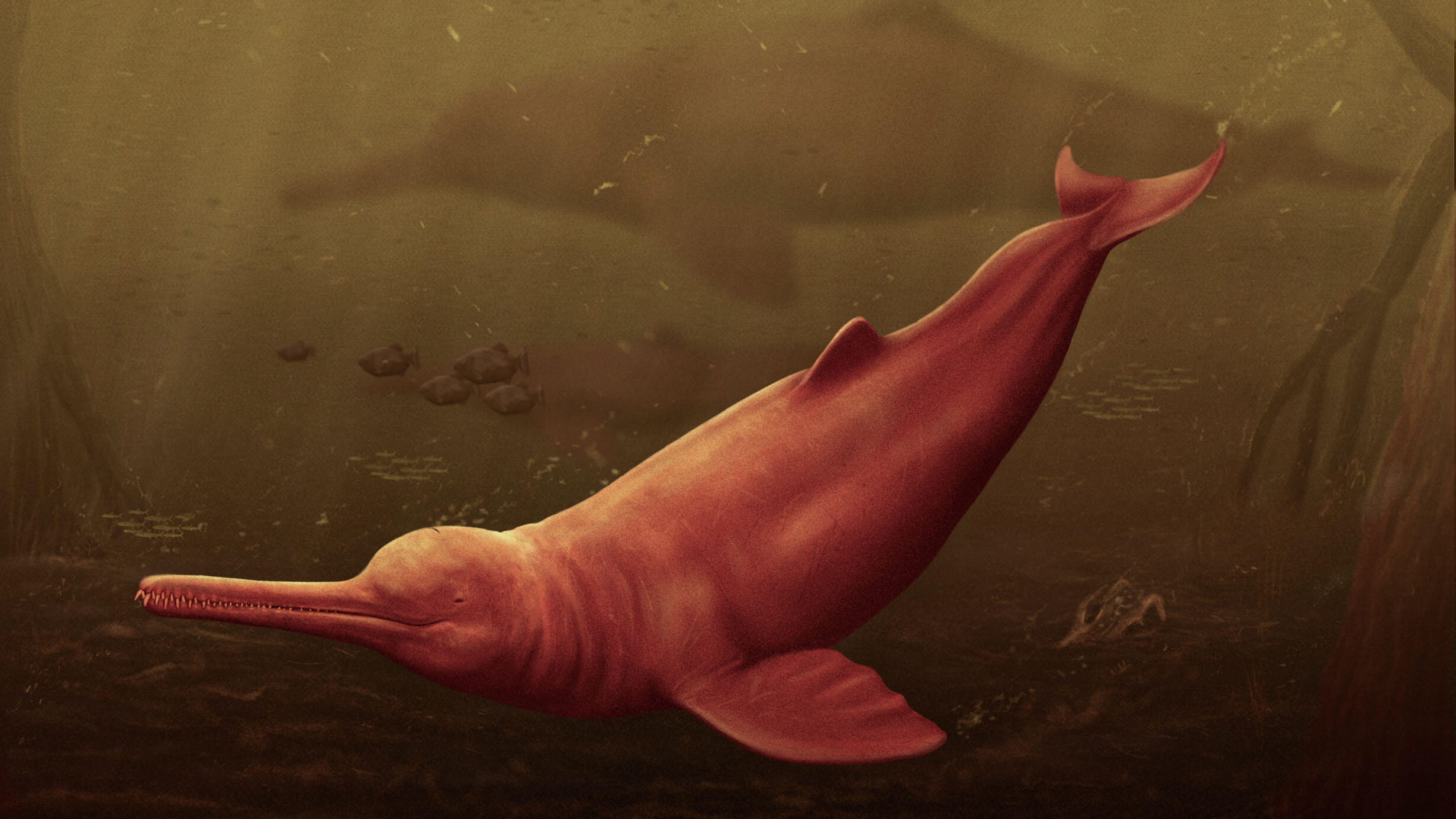 Artistic reconstruction of Pebanista yacuruna in the murky waters of the Peruvian proto-Amazonia.
Artistic reconstruction of Pebanista yacuruna in the murky waters of the Peruvian proto-Amazonia. Jaime Bran
An international team of scientists has discovered the largest known freshwater dolphin, an ancient species that lived in the Peruvian Amazon about 16.5 million years ago.
Surprisingly, the dolphin’s closest living relative is not the Amazon River dolphin—a critically endangered species endemic to South America also known as the pink dolphin—but the river dolphins of South Asia. The new species, Pebanista yacuruna, which is named in part for an ancient wetlands and in part for the Kichua name for mythical aquatic people believed to live in the Amazon basin, belonged to a group of dolphins that were common not only in South Asia but in the world’s oceans between 24 and 16 million years ago.
“At the time this ancient fossil river dolphin lived, the Amazon basin didn’t yet have its giant river flowing east to the Atlantic,” said the Museum’s Frick Curator of Fossil Mammals John Flynn, a co-author on the new study, which is published today in the journal Science Advances. “That landscape contained massive wetlands, including a grouping of lakes and swamps called the Pebas mega-wetland system. Discoveries by our international collaborative teams tell us the kinds of tropical life that existed during times in Earth’s history when virtually nothing had been known before—and this is crucial to understanding the history and pathways that led to the remarkably rich modern Amazonian biodiversity.”
Aldo Benites-Palomino
Since 2002, Flynn has been co-leading expeditions with long-time Peruvian collaborator and Museum research associate Rodolfo Salas-Gismondi and other colleagues at fossil outcrops of the Pebas Formation in northeastern Peru, excavating extinct animal and plant life from the Miocene. They’ve discovered a rich diversity of fossils, including a geologically younger assemblage of crocodiles containing more species in a single locality than in any other time or place in the fossil record, as well as fossil mammals, turtles, fishes, and many other fossil groups.
In 2018, Flynn joined the expedition led by Salas-Gismondi, a paleontologist at the Museo de Historia Natural and Universidad Peruana Cayetano Heredia in Lima, and helped discover the new river dolphin skull. Analysis of the fossil, conducted by Aldo Benites-Palomino, a paleontologist at the University of Zurich and lead author of the study, found that Pebanista was likely between 10-11.5-feet (3-3.5 meters) long.
Aldo Benites-Palomino
“We discovered that its size is not the only remarkable aspect,” said Benites-Palomino. “With this fossil record unearthed in the Amazon, we expected to find close relatives of the living Amazon River dolphin. But instead, the closest cousins of Pebanista are the South Asian river dolphins.”
Pebanista and the South Asian river dolphins, Platanista, both share highly developed facial crests, which are specialized bony structures associated with echolocation—the ability to “see” by emitting high-frequency sounds and listening to their echoes. Dolphins rely heavily on echolocation for hunting, especially river dolphins, which have to navigate muddy waters. Pebanista had an elongated snout with many teeth, which implies that it fed on fish, as other species of river dolphins do today.
When the Peruvian Pebas mega-wetland system began to give way to modern Amazonia about 10 million years ago, new habitats and prey appeared, driving Pebanista to extinction, the authors suggest.
The shift opened an ecological niche that then was exploited by ancient relatives of today’s very distantly related Amazon River dolphins (Inia), a lineage that also was facing extinction in the oceans due to the rise of other new cetacean groups, including modern oceanic dolphins.